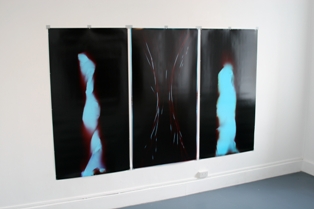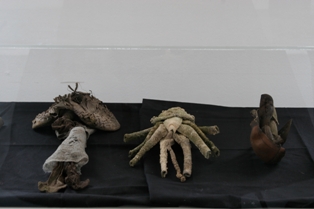Process Room, 20.05.08- 29.05.08
Fertile Ground
The images presented in the Process Room are the result of the contact of photographic paper with various forms, they are created at night in my studio. This process registers as a deep liquescence within the images. The materials used are located and taken from areas which I call Fertile Grounds.
Fertile Grounds exist in many places, an area can remain a Fertile Ground for many years, or in some cases for just a few hours. The images before you, for example, consist in part of many sections of a steel fence. Over the years the fence has been warped in specific places through the actions of hundreds, if not thousands of people breeching the fence at certain points in order to pass through it to engage in often illegal or sexual acts. It is in these acts of transgression, fucking in a public park for example, that I am attracted to, that is not to say I want to witness the acts nor am I interested in the specific individuals who cross these boundaries. What I am drawn to is the inherent resistance and defiance of these and other such acts.
I take the warped sections of the fence and others like it. I assemble the distressed shapes of the abandoned sections of fence so that it’s having bore witness to an accumulation of prior transgressions which, over time, remain visible. The resulting image flows between being the literal representation of a steel fence to something purely anthropological; the study of human actions, while also having a medical/internal appearance, finally becoming a study of the Void, as both orificial and as a space that shall always remain outside conventional experience, alien.
Those
With a similar methodology, for the series Those, I hunt for, locate, and gather items of clothing from the Fertile Grounds. The clothing is then disassembled and reassembled by myself. When re-formed it mimics potential organic life forms. This passivity is possible precisely because there is no way to know the situations that led to the abandonment of the items of clothing and therefore there exists a great potential in the ability to reconfigure the clothing and re-present it as both fictitious and yet almost believable.
Furthermore, the life-forms, the flora and fauna, have at the basis of their structure a sexual disposition; being either of a phallic or vaginal form, or in some cases both (as are most flowers). This appearance could be termed a form of ‘genetic hereditary’; for, as stated earlier, the Fertile Ground from which these life-forms were born is rich in activities of a sexual nature. There are quite literally trillions of human sperm cells proliferated in such areas. It then follows, that the fruits of these spaces, the clothing, left behind in an unknown act, are both sexual and mysterious in their fabric and functions. All of the organisms intentionally generate associations with Natural History, fossils, collections, the aborted and the stillborn. Danny Treacy _ ARP ‘08
“To point to an object which one wants, but which one cannot, or refuses to name and to say, with one’s eye as much as with one’s finger, “Those”. In language, those, when unhinged from a noun, is an empty sign awaiting an object. In Treacy’s work it is also an act of refusal: to name. Through his patchworks of sloughed skins, a nameable and law-abiding thing, or body, or structure, falls into the realm of the un-nameable, forcing us, behind him, to trespass and intrude into innumerable, ultimately individual boundaries. Each work speaks in an excessive, coded and unapologetically private way. As utterance, they are spoken in a profane language. If a translation were possible, it could not be reproduced here.”
© Becky Beasley, excerpt from a commissioned essay written for portfolio catalogue, 2006.
Danny Treacy holds an MA in Fine Art Photography from the Royal College of Art in London. He has won various awards including the inaugural Jerwood/Portfolio Photography Award and the Photographer’s Gallery Award. Treacy’s work has been featured in numerous International exhibitions in Portugal, Finland, Spain, Edinburgh, California, London, France, Italy and Canada. His work has been written about in Portfolio Catalogue, Photoworks, Another Magazine, and I-D Magazine, amongst others. Current exhibitions include In Our World: New Photography In Britain, a group show curated by Filippo Maggia, Galleria Civica di Modena, Italy, April – July 2008 and Treacy has a forthcoming solo show at The Photographers Gallery, London, July – September 2008. Further information on Danny Treacy can be found at www.dannytreacy.com.
For a printable version of this information please download the following documentDanny Treacy: Fertile Ground & Those (Word doc 2000 – 192KB)
Click here to return to Previous Participants
Click  here to browse ARP Projects
here to browse ARP Projects

